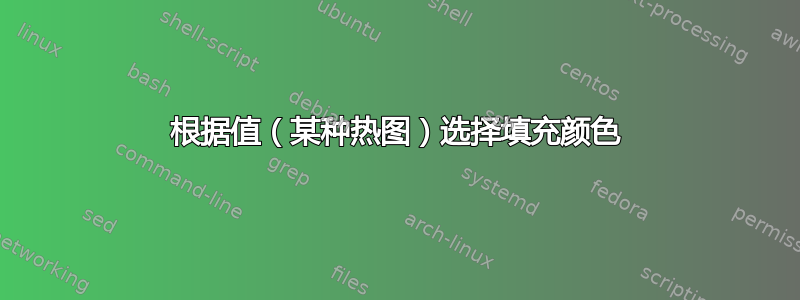
我有一组预定义的坐标,\where,以及一个对应的值。每个坐标覆盖一个矩形。我喜欢根据值\value选择选项的颜色。结果是热图 - 但绘制在 之外。fill=...pgfplot
我已经看到pgfplot可以绘制热图,但是我需要在现有图形上绘制地图。尽管,绘图colormap/jet的pgfplot接缝确实很好。因此,如果可能的话,我喜欢有一个选择颜色的函数colormap/jet。我还需要一个条形图(颜色,对应值)。
\documentclass[border=5mm]{standalone}
\usepackage{tikz}
\usetikzlibrary{calc}
\begin{document}
\begin{tikzpicture}
%existing figure
\draw (0,1) circle (1);
\draw (1,2) circle (.7);
%heatmap
\foreach \where/\value in
{ (0,0)/0.5,(1,0)/0.3,(2,0)/0.1, %coordinates and values between 0 and 1
(0,1)/0.3,(1,1)/0.2,(2,1)/0.05,
(0,2)/0.1,(1,2)/0.4,(2,2)/0.2%
}
{ \path [overlay] \where coordinate (A);
\draw [fill=orange, , opacity=0.2] ($(A)-(.5,.5)$) rectangle ($(A)+(.5,.5)$); } %fill with the correct color
%add a color bar
\end{tikzpicture}
\end{document}
答案1
使用该xcolor包,您可以使用语法
<color>!<percent>
获得颜色的阴影:
代码:
\documentclass[border=5mm]{standalone}
\usepackage{tikz}
\usetikzlibrary{calc}
\begin{document}
\begin{tikzpicture}
%existing figure
\draw (0,1) circle (1);
\draw (1,2) circle (.7);
%heatmap
\foreach \where/\value in
{ (0,0)/50,(1,0)/30,(2,0)/10, %coordinates and values between 0 and 100
(0,1)/30,(1,1)/20,(2,1)/5,
(0,2)/10,(1,2)/40,(2,2)/20%
}
{ \path [overlay] \where coordinate (A);
\draw [fill=red!\value, opacity=0.2] ($(A)-(.5,.5)$) rectangle ($(A)+(.5,.5)$); } %fill with the correct color
%add a color bar
\end{tikzpicture}
\end{document}
答案2
您可以计算 rgb 值并相应地为方块着色。
\documentclass[border=5mm]{standalone}
\usepackage{tikz}
\usepackage{ifthen}
\usepackage{xcolor}
\usetikzlibrary{calc}
\begin{document}
\begin{tikzpicture}
%heatmap
\foreach \where/\value in {
(0,0)/0.5,(1,0)/0.3,(2,0)/0.1, %coordinates and values between 0 and 1
(0,1)/0.3,(1,1)/0.2,(2,1)/0.05,
(0,2)/0.1,(1,2)/0.4,(2,2)/0.2%
}{
\path [overlay] \where coordinate (A);
\pgfmathsetmacro \v \value
\ifthenelse{\lengthtest{\v pt>0.333pt}}{
\pgfmathsetmacro \r {1}
\pgfmathsetmacro \g {1-(\value-.333)/.667}
\pgfmathsetmacro \b {0}
}{
\pgfmathsetmacro \r {\value/.333}
\pgfmathsetmacro \g {\value/.333}
\pgfmathsetmacro \b {1-\value/.333}
}
\definecolor{temp}{rgb}{\r, \g, \b}
\draw [fill=temp] ($(A)-(.5,.5)$) rectangle ($(A)+(.5,.5)$);
}
%colour bar
\fill[top color=red, bottom color=yellow] (-1.5,.5) rectangle (-2,2.5) node[left] {1};
\fill[top color=yellow, bottom color=blue] (-2,-.5) node[left] {0} rectangle (-1.5,.5);
%existing figure
\draw (0,1) circle (1);
\draw (1,2) circle (.7);
\end{tikzpicture}
\end{document}
\documentclass[border=5mm]{standalone}
\usepackage{tikz}
\usepackage{ifthen}
\usepackage{xcolor}
\usetikzlibrary{calc}
\begin{document}
\begin{tikzpicture}
%heatmap
\foreach \where/\value in { (0,0)/0.0,(1,0)/0.1,(2,0)/0.2, (0,1)/0.3,(1,1)/0.4,(2,1)/0.5, (0,2)/0.6,(1,2)/0.7,(2,2)/0.8, (0,3)/0.9,(1,3)/1.0 } {
\path [overlay] \where coordinate (A);
\pgfmathsetmacro \v \value
\ifthenelse{\lengthtest{\v pt>0.333pt}}{
\pgfmathsetmacro \r {1}
\pgfmathsetmacro \g {1-(\value-.333)/.667}
\pgfmathsetmacro \b {0}
}{
\pgfmathsetmacro \r {\value/.333}
\pgfmathsetmacro \g {\value/.333}
\pgfmathsetmacro \b {1-\value/.333}
}
\definecolor{temp}{rgb}{\r, \g, \b}
\draw [fill=temp] ($(A)-(.5,.5)$) rectangle ($(A)+(.5,.5)$);
}
%colour bar
\fill[top color=red, bottom color=yellow] (-1.5,1) rectangle (-2,3) node[left] {1};
\fill[top color=yellow, bottom color=blue] (-2,0) node[left] {0} rectangle (-1.5,1);
%existing figure
\draw (0,1) circle (1);
\draw (1,2) circle (.7);
\end{tikzpicture}
\end{document}
答案3
对于所示示例,我并不认为您需要在 PGFPlotsaxis环境之外绘制“现有图形”。但即使确实如此,您也可以将 PGFPlots 坐标系与 tikz 坐标系匹配然后使用 PGFPlots 提供的所有可能性来绘制热图。
我还想提一下,我会反过来画。所以首先画热图,然后在上面画“现有图形”。然后颜色就与颜色条中的颜色真正匹配了,颜色条没有任何透明度。(我不认为有一种简单的方法可以只让颜色条透明——没有框架、刻度和标签——这样它就会与情节相匹配。如果我错了,我很乐意在这里告诉你。)
请查看代码中的注释以了解更多详细信息。
\documentclass[border=1mm]{standalone}
\usepackage{tikz}
\usepackage{pgfplots}
\pgfplotsset{compat=1.11}
\begin{document}
\begin{tikzpicture}
% if you really need to draw the figure outside the axis environment
% of the PGFPlots package ...
% -----------------------
% existing figure
\begin{scope}[
thick,
red,
]
\draw (0,1) circle (1);
\draw (1,2) circle (.7);
\end{scope}
% -----------------------
\begin{axis}[
% -----------------------------------------------------------------
% in case you really want matching coordinate systems between
% `tikz' and `pgfplots'
% (taken from PGFPlots manual v1.13 section 4.26)
% -----------------------------------------------------------------
% tell pgfplots to "grab" the axis at its
% internal (0,0) coord:
anchor=origin,
% tell pgfplots to place its anchor at (0,0):
% (This is actually the default and can
% be omitted)
at={(0pt,0pt)},
% tell pgfplots to use the "natural" dimensions:
disabledatascaling,
% tell pgfplots to use the same unit vectors
% as tikz:
x=1cm,y=1cm,
% -----
% not needed here, because the axes themselves are not needed (see below)
% % range... try it out.
% xmin=-1,xmax=3,
% ymin=-1,ymax=3,
% -----
% -----------------------------------------------------------------
%
% choose a colormap that fits your need and draw the colorbar
% (to change position and style of the colorbar please have a look
% at the PGFPlots manual section 4.9.13 (in v1.13))
colormap/viridis,
colorbar,
%
% set min and max vales for `meta' values (and therefore the colorbar)
point meta min=0,
point meta max=0.5, % <-- here a lower value to better show the
% the differences of the given values
%
% use opacity, if you really want to draw the other figure below
% the "heat map"
matrix plot*/.append style={
opacity=0.5,
},
% because the axes are not needed -> hide them
hide axis,
% and because without drawing the axes we do not need to specify
% axis limits. But to ensure that all "non-\addplot" stuff is fully
% drawn, disable clipping
clip=false,
]
% I think it is not a problem to draw your figure also inside
% of the axis environment
% -----------------------
% existing figure
\draw (0,1) circle (1);
\draw (1,2) circle (.7);
% -----------------------
\addplot [
matrix plot*,
point meta=explicit,
% draw=black, % <-- change me, if the default doesn't fit your needs
]
table [x=x,y=y,meta=z] {
x y z
0 0 0.5
1 0 0.3
2 0 0.1
0 1 0.3
1 1 0.2
2 1 0.05
0 2 0.1
1 2 0.4
2 2 0.2
};
\end{axis}
\end{tikzpicture}
\end{document}







